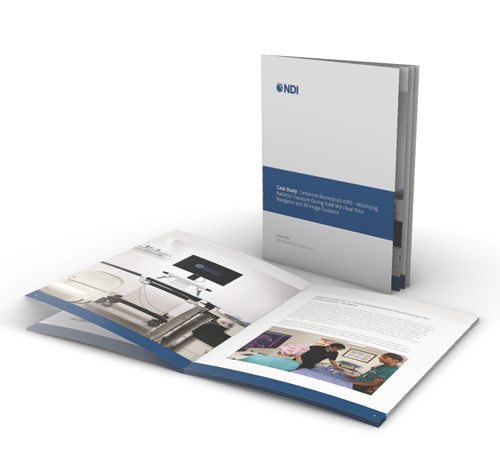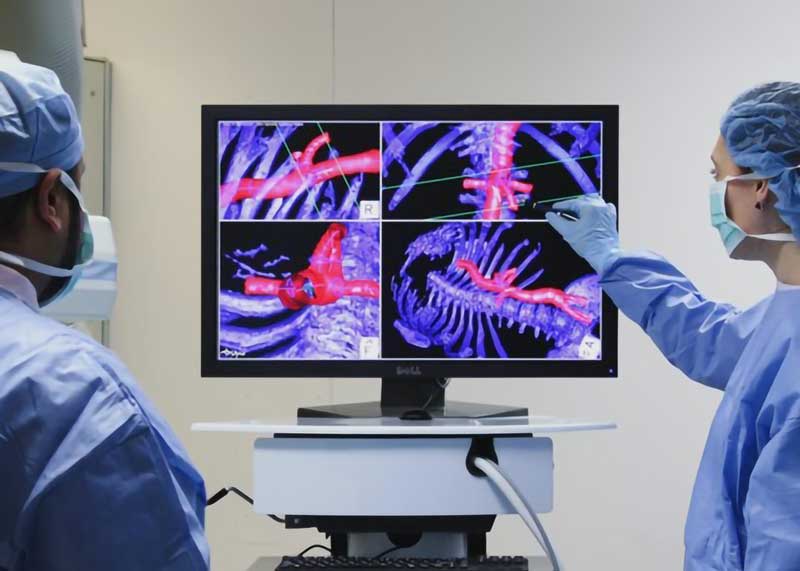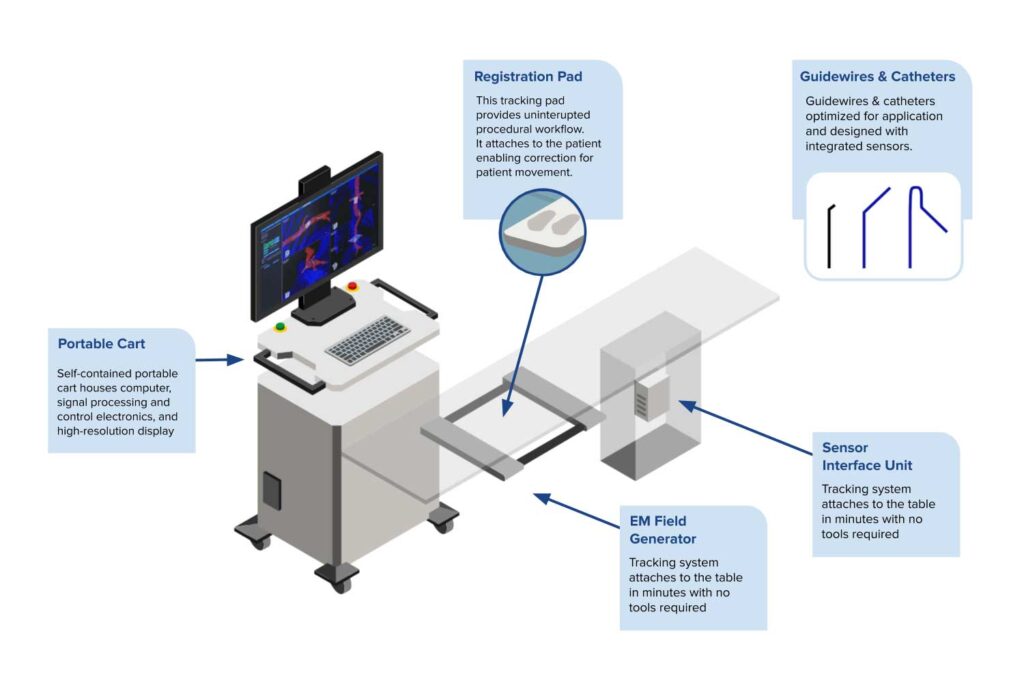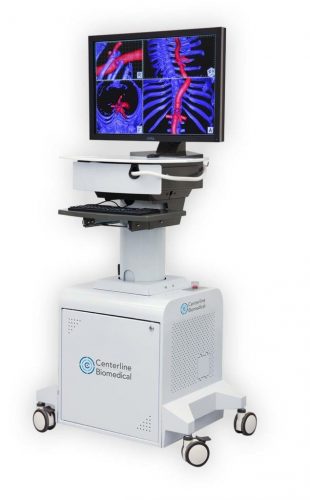Experience the Future of Endovascular Surgery with Centerline Biomedical’s IOPS® 3D Image-Guided System — Leveraging NDI’s Aurora® Electromagnetic Navigation Technology
Transition away from lengthy endovascular procedures and embrace a new era of unparalleled navigation accuracy while minimizing radiation exposure from X-rays.
In collaboration with NDI, Centerline Biomedical engineered a revolutionary solution that redefines the landscape of endovascular surgery.
Centerline’s IOPS® (Intra-Operative Positioning System) 3D surgical and interventional navigation technology provides practitioners with non-radiation-based navigation of catheters and guidewires during endovascular procedures. The system combines high-quality 3D colour image guidance and real-time interactive navigation and positioning capabilities that benefit practitioners and patients by:
- Displaying an intuitive anatomical 3D map based on image-fusion
- Providing precise and accurate electromagnetic navigation
- Improving endovascular procedure patient outcomes
- Delivering a safer clinical environment due to less radiation exposure
- Reducing procedure times, thereby increasing the number of daily procedures

By submitting this form, I acknowledge I’ve reviewed and accepted NDI’s privacy policy.
Navigating a New Era in Pediatric Scoliosis Treatment: nView medical and NDI Revolutionize Spinal Fusion with 3D Image Guidance Technology
Delivering Real-Time Value to Practitioners and Patients
For decades, practitioners and patients have been exposed to prolonged radiation from x-rays during endovascular surgery. These procedures are conventionally navigated using fluoroscopy, an X-ray imaging modality. The actual three-dimensional blood vessels are often complex and tortuous, but the fluoroscopy images provide only two-dimensional visualizations in which the vessels themselves are essentially invisible. Contrast dye can be injected to briefly highlight the blood vessels, but this chemical is toxic, and its use must be limited. This poses a challenge in the accurate placement of catheters, guidewires and stents during endovascular procedures, requiring trial and error and frequent movement of the large imaging system. As a result, fluoroscopy can be a significant source of radiation exposure to a clinician, which is of concern when procedures last for many hours.
Although minimally invasive endovascular procedures have been a positive technological advancement, the technical challenges and lengthy radiation exposure are problematic. This is where Centerline Biomedical’s IOPS 3D image- guidance technology is changing this landscape.

A Paradigm Shift – Improving Safety and Accuracy During Endovascular Procedures
Vikash Goel, Founder and Chief Technology Officer of Centerline Biomedical, was part of a team of engineers at Cleveland Clinic dedicated to advancing technologies behind minimally invasive vascular surgery. He and his colleagues were deeply immersed in the surgical environment. They saw the need to create an innovative solution to address technical challenges and reduce patient and practitioner radiation exposure.
Determined to make a difference, and leveraging advanced training in computer science, computer graphics, electrical engineering, mechanical engineering, and biomedical engineering, the team invented Centerline’s innovative Intra-Operative Positioning System (IOPS). Having developed sophisticated image processing and mapping algorithms and seen the power of electromagnetic navigation in electrophysiology and bronchoscopy procedures, they conceived of IOPS as a 3D surgical and interventional navigation technology to provide practitioners with an intuitive 3D map for real-time non- radiation-based navigation of catheters, and guidewires. This map is derived from a patient’s computed tomography (CT) scan data and fused with real-time imaging. For the underlying electromagnetic tracking technology, they partnered with NDI (Northern Digital Inc), an industry leader with over 40 years of expertise and innovation in optical and electromagnetic navigation technology.
NDI’s EM Technology Brings Real-Time 3D EM Tracking to IOPS
NDI’s Aurora® EM technology solution generates a defined EM field in which EM micro-sensors are tracked, requiring no line of sight. The Field Generator emits a low-intensity, varying EM field that establishes the measurement volume. Small currents are induced in micro-sensors and amplified and digitized by the Sensor Interface Unit. The sensors’ position and orientation is calculated by the System Control Unit.
These components are integrated into IOPS. The combination of NDI’s and Centerline Biomedical’s proprietary technologies produces accurate real-time color 3D image guidance. In the clinical environment, this means interactive 3D image guidance without continuous fluoroscopic imaging.

Powered by NDI’s Microsensors
The IOPS platform consists of a self-contained mobile cart as well as sterile single-use interventional tools. IOPS catheters and guidewires are designed with integrated NDI microsensors in their distal tips, enabling the proprietary IOPS software to monitor and model the locations, orientations, and shapes of these devices. A sensor-embedded self-adhesive registration pad placed on the patient’s back enables patient registration. The telemetry from these sensors enables IOPS’ powerful interactive device guidance through the 3D vessel map.
Interactive Navigation with Real-Time Positioning
During a surgical procedure, the IOPS’ EM navigation technology provides real-time visualization of the position and orientation of the catheter, and guidewire, as well as the patient’s anatomy. This information is delivered to the operating suite monitor giving practitioners a clear full-color display of the relevant
vessels and anatomy along with the interventional tools. Up to four simultaneous viewports allow for easy appreciation of the complex three-dimensional geometry. Each viewpoint can be customized with viewing angle, magnification, and viewing position, allowing practitioners to be deliberate with device positioning and manipulation.
Merging real-time data from the EM sensors in the registration pad with the IOPS mapping and navigation software means that if the patient or the field generator is moved on the table, IOPS will correct the image on the screen in real-time without continuous fluoroscopy. This enables precise placement of implants and accurate vessel navigation.
Interactive Navigation with Real-Time Positioning
The value of IOPS lies in its potential to:
- Mitigate radiation exposure
- Provide interactive navigation with real-time positioning
- Produce accurate high-quality 3D color image guidance
- Reduce surgical times
- Function as a portable unit that easily integrates into typical workflows
These capabilities stand to benefit practitioners, patients, and healthcare economics by providing:
- Precise and accurate navigation.
- Improved endovascular procedure outcomes for patients.
- A safe environment for practitioners and patients due to less radiation exposure.
- A reduction in procedural time and an increased number of daily procedures.
IOPS FDA Clearance l and Future Areas of Opportunity
The IOPS currently has FDA clearance for use in the descending aorta and is available in the United States. It is currently being used in simple and complex endovascular aneurysm repair (EVAR) procedures as well as in other therapeutic and diagnostic procedures such as renal artery stenting and mesenteric angioplasty.
Centerline Biomedical sees additional potential applications in a wide variety of minimally invasive interventions, including:
- Transcatheter structural heart interventions
- Peripheral artery disease interventions
- Neurovascular interventions
Industry Leaders Transforming Endovascular Navigation
About NDI
NDI is an industry leader with over 40 years of expertise and innovation in optical and electromagnetic navigation technology. The Aurora electromagnetic tracking solution provides unobstructed real-time tracking of microsensors that can be embedded into catheters, guidewires, and other OEM medical instruments. The benefits of no line of sight and in-vivo tracking are that clinicians can execute minimally invasive surgeries through complex vasculature and anatomy. In addition, the data from the Aurora EM system enables practitioners to have real-time navigation allowing them to know the accurate position and orientation of the patient and instruments.
About Centerline Biomedical
Centerline Biomedical, Inc. was founded to develop and commercialize the IOPS technology originally created in Cleveland Clinic’s Heart and Vascular Institute and Lerner Research Institute. The startup is driven by a mission to reduce radiation exposure and advance navigation accuracy to benefit patients and caregivers alike. The first FDA-cleared IOPS products entered the US market in 2020. Headquartered in Cleveland, Ohio, USA, the company has been recognized for its innovation and leadership by local, national, and international entities. Today Centerline Biomedical is changing endovascular practice with its on-market products while rapidly innovating to expand its platform’s reach.
Developing a Safer Surgical Environment for Practitioners and Patients
Although the technology behind endovascular tools and implants has advanced, 2D x-ray fluoroscopy remains the standard means of guidance for endovascular surgeries. This modality leaves practitioners, and patients exposed to prolonged radiation while making these procedures challenging and long in duration.
The IOPS system provides a safe, efficient adjunct to fluoroscopy that stands to significantly reduce radiation exposure and increase accuracy and speed for endovascular procedures. IOPS provides a solution that aligns with growing legislation around mitigating radiation risks for practitioners and patients.
Together, Centerline Biomedical and NDI believe in safer, more efficient, and more effective endovascular procedures. IOPS is leading the way.

Download the Case Study: Navigating the Future of Endovascular Surgery with IOPS®
Presented by Centerline Biomedical and NDI
Discover the innovative IOPS® 3D Image-Guided System with a digital version of the case study. Learn how this technology, created with NDI, transforms endovascular surgery through advanced electromagnetic navigation, reduced radiation, and enhanced procedural efficiency. Ideal for offline reference, this document is an essential resource for practitioners.
